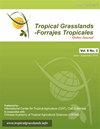Canopy characteristics of ‘Mavuno’ hybrid brachiariagrass and ‘Marandu’ palisadegrass harvested at different harvest intensities
IF 0.7
4区 农林科学
Q3 AGRICULTURE, DAIRY & ANIMAL SCIENCE
引用次数: 2
Abstract
‘Mavuno’ is a newly released brachiariagrass (Urochloa hybrid) cultivar with limited information available in the literature. The objective of this study was to compare forage characteristics of this cultivar and ‘Marandu’ palisadegrass [Urochloa brizantha (Hochst. ex A. Rich.) R.D. Webster cv. Marandu] harvested at 2 different stubble heights during 2 growing seasons (January‒April). The study was conducted in Araguaína, TO, Brazil in 2017 and 2018. Treatments were the factorial arrangement of 2 brachiariagrass cultivars, Mavuno and Marandu, harvested at 2 harvest intensities, 5 and 15 cm stubble height, distributed in a randomized complete block design with 4 replicates. Response variables were canopy height, forage accumulation, proportion of leaf, stem and dead material, and concentration of crude protein (CP) and in vitro digestible organic matter (IVDOM). Mavuno and Marandu did not differ (P>0.05) in forage accumulation (mean = 3,800 kg DM/ha/harvest) and IVDOM concentration (mean = 637 g/kg); however, Mavuno had lower CP concentration (101 vs. 110 g/kg), greater proportion of stems (16 vs. 13%) and less dead material (4 vs. 6%) than Marandu (P<0.05). Harvesting at 5 cm stubble height rather than 15 cm increased herbage accumulation per harvest (4,100 vs. 3,500 kg DM/ha) with decreased proportion of leaves (77 vs. 84%) and CP concentration (101 vs. 115 g/kg) (P<0.05). Our data suggest that Mavuno is a useful addition to the range of brachiaria grass cultivars for sowing in tropical regions and further studies are needed to evaluate the long-term persistence of Mavuno under different management practices in a range of environmental situations. While harvesting at 5 cm stubble height rather than 15 cm increased forage accumulation but reduced CP concentration, regardless of cultivar, longer-term effects on the stability of these pastures with these harvest frequencies and heights are open to question and studies should be continued for longer periods to assess longevity of stands under the 2 management strategies. Applying maintenance fertilizer during the growing season might have prevented the marked decline in dry matter accumulation as the season advanced and this hypothesis should be tested.不同收获强度下‘马夫诺’杂交腕足草和‘马兰度’栅栏草的冠层特征
“Mavuno”是一种新发布的腕草(Urochloa杂交种)品种,文献中可用的信息有限。本研究的目的是比较该品种和在2个生长季节(1-4月)在2个不同残茬高度收获的“Marandu”栅栏草[Urochloa brizantha(Hochst.ex A.Rich.)R.D.Webster cv.Marandu]的饲料特性。这项研究于2017年和2018年在巴西TO的阿拉瓜伊纳进行。处理是2个腕草品种Mavuno和Marandu的析因安排,以2个收获强度、5厘米和15厘米的残茬高度收获,以随机完全块设计的方式分布,4个重复。响应变量为冠层高度、牧草积累、叶、茎和死物质比例、粗蛋白(CP)和体外可消化有机物(IVDOM)浓度。Mavuno和Marandu在饲料积累(平均=3800 kg DM/ha/收获)和IVDOM浓度(平均=637 g/kg)方面没有差异(P>0.05);Mavuno具有较低的CP浓度(101对110g/kg),与Marandu相比,茎的比例更大(16%对13%),死物质的比例更少(4%对6%)(P<0.05)。在5厘米的残茬高度而不是15厘米的收割增加了每次收割的牧草积累(4100对3500公斤DM/ha),而叶的比例(77对84%)和CP浓度(101对115 g/kg)则有所下降(P<0.05)需要进一步的研究来评估Mavuno在各种环境条件下在不同管理实践下的长期持久性。尽管在5厘米的残茬高度而不是15厘米的收割增加了饲料积累,但降低了CP浓度,无论品种如何,在这些收割频率和高度下,对这些牧场稳定性的长期影响是有疑问的,应继续进行更长时间的研究,以评估两种管理策略下林分的寿命。在生长季节施用维持性肥料可能会防止随着季节的推移干物质积累的显著下降,这一假设应该得到检验。
本文章由计算机程序翻译,如有差异,请以英文原文为准。
求助全文
约1分钟内获得全文
求助全文
来源期刊

Tropical Grasslands-Forrajes Tropicales
Agricultural and Biological Sciences-Agronomy and Crop Science
CiteScore
1.60
自引率
0.00%
发文量
36
审稿时长
16 weeks
期刊介绍:
The Journal publishes, in English or Spanish, Research Papers and Short Communications on research and development, as well as contributions from practitioners (Farmer Contributions) and Review Articles, related to pastures and forages in the tropics and subtropics. There is no regional focus; the information published should be of interest to a wide readership, encomprising researchers, academics, students, technicians, development workers and farmers.
In general, the focus of the Journal is more on sown (''improved'') pastures and forages than on rangeland-specific aspects of natural grasslands, but exceptions are possible (e.g. when a submission is relevant for a particularly broad readership in the pasture and forage science community).
The Journal will also consider the occasional publication of associated, but closely related, research in the form of an additional scientific communication platform [e.g. a re-make of the former Genetic Resources Communication series of the former Division of Tropical Crops and Pastures of the Commonwealth Scientific and Industrial Research Organisation (CSIRO), Australia].
Areas of particular interest to the Journal are:
Forage Genetic Resources and Livestock Production[...]
Environmental Functions of Forages[...]
Socio-economic Aspects[...]
Topics within the aforementioned areas may include: Diversity evaluation; Agronomy; Establishment (including fertilization); Management and utilization; Animal production; Nutritive value; Biotic stresses (pests and diseases, weeds); Abiotic stresses (soil fertility, water, temperature); Genetics and breeding; Biogeography and germplasm collections; Seed production; Ecology; Physiology; Rhizobiology (including BNF, BNI, mycorrhizae); Forage conservation; Economics; Multilocational experimentation; Modelling.
 求助内容:
求助内容: 应助结果提醒方式:
应助结果提醒方式:


